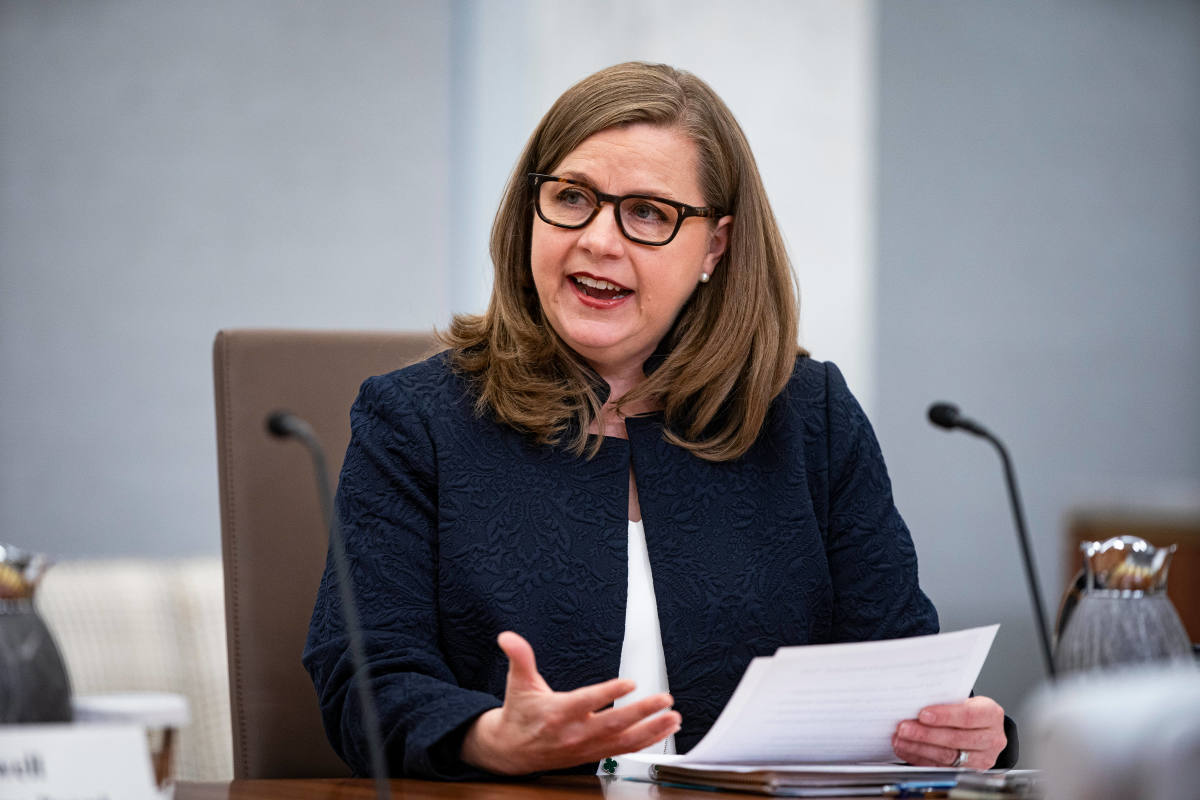Is the long wait to cut interest rates winding down?
Federal Reserve Governor Michelle Bowman wants the Fed to ditch its “wait-and-see” approach to monetary policy and begin to substantially lower interest rates starting next month.
In her remarks, Bowman cited weakness in recent labor market data, plus signs that tariff inflation appears transitory, before regional senior banking leaders Aug. 9 in Colorado.
Related: A divided Federal Reserve mulls interest rate cut after wild week
She warned that failure to implement multiple cuts in the benchmark Federal Funds Rate this year would risk longer-term economic instability.
Her speech came two days after President Donald Trump nominated long-time ally Stephen Miran to fill a temporary vacancy at the Fed, sparking concerns of increasing politicization of the independent central bank.

Image source: Bloomberg/Getty Images
Fed holds rates steady thus far in 2025
The Federal Open Market Committee last cut the Federal Fund Rates in December 2024.
Fed Chair Jerome Powell has been under heavy fire from the White House for several months to slash rates from the current 4.25% to 4.50% level.
Bowman and Fed Governor Christopher Waller, Trump appointees along with Powell, dissented from the July FOMC vote to create a historic split from the other members of the 12-person panel.
Seven of those members are Fed Board of Governors, the other five rotate from the heads of the regional Federal Reserve banks.
Both Bowman and Waller said early signs of weakness in the labor market justified a .25-percentage-point cut.
It was the first FOMC dissent since 1993.
How the Fed balances prices, jobs
The Federal Reserve’s dual mandate from Congress requires monetary policy that balances low unemployment and low inflation.
The Fed uses interest rates as the benchmark tool to maintain both sides of its mandate.
But there is tension between the two.
Higher interest rates lower inflation but increase job losses, while lower interest rates decrease unemployment but increase inflation.
Related: Federal Reserve votes on interest rates
The Federal Funds Rate is the interest rate banks pay to borrow money overnight.
It sets the cost of short-term borrowing — for example, the interest on credit cards, auto loans, home equity loans, and student loans.
When the Fed raises rates, yields on short-term securities typically climb and push up longer-term yields like the 10-year Treasury Bond. (Investors demand higher returns to offset anticipated inflation and tighter credit conditions.)
The 10-year Treasury yield is a benchmark for U.S. mortgage rates because lenders use it to price long-term loans. As the yield rises, mortgage rates usually increase, making borrowing more expensive for homebuyers. Conversely, when the yield drops, so do mortgage rates.
President Trump has been demanding a 3-percentage-point rate cut, saying it is necessary to curb recession fears, ease the stagnant housing market with lower mortgages, and reduce the interest on the federal deficit.
He has lashed out at the Fed chair with heated name-calling (“Too Late Powell”) and other taunts.
Bowman’s reasons for 2025 interest rate cuts
Bowman called on the FOMC to perform three interest rate cuts of .25 this year, starting with its Sept. 17 meeting. The FOMC also meets in October and December.
“A proactive approach in moving policy closer to neutral, from its current moderately restrictive stance, would help avoid a further unnecessary erosion in labor market conditions and reduce the chance that the (FOMC) will need to implement a larger policy correction should the labor market deteriorate further,’’ Bowman said in prepared remarks.
Bowman said it appears that inflation data is heading downward toward the Fed’s 2% target, signaling that price hikes from the highest U.S. tariffs in nearly a century may be a single bump and not long term.
More Federal Reserve:
- GOP plan to remove Fed Chair Powell escalates
- Trump deflects reports on firing Fed Chair Powell ‘soon’
- Former Federal Reserve official sends bold message on ‘regime change’
“As I gain even greater confidence that tariffs will not present a persistent shock to inflation, I see that upside risks to price stability have diminished,” Bowman said.
“With underlying inflation on a sustained trajectory toward 2%, softness in aggregate demand and signs of fragility in the labor market, I think that we should focus on risks to our employment mandate,” she said.
Jobs data sparks concern for economists, market
Earlier in the week, Minneapolis Fed President Neel Kashkari, San Francisco Fed President Mary Daly, and Fed Governor Lisa Cook also expressed concern over new figures that show a sharp cooling in the labor market.
Employers added a lower-than-expected 73,000 jobs in July, and gains in May and June were revised down by nearly 260,000, according to the Bureau of Labor Statistics. The unemployment rate inched up to 4.2% from 4.1% in June.
Bob Fraser, CIO and co?founder of Aspen Funds, oversees more than $600 million across private credit and alternative income strategies. He expressed concern about multiple rate cuts in 2025.
“Weak July employment data has definitely strengthened the case for cuts,” Fraser told TheStreet. He added that Atlanta Fed President Raphael Bostic recently noted that hiring revisions were significant but reiterated his expectation of only one rate cut in 2025.
“All this implies that any rate cuts will likely be uneven and cautious, especially if inflation continues to prove sticky,’’ he said.
The CME Group’s widely watched FedWatch Tool forecasts the likelihood of September rate cut at 88.9%.
Related: Trump makes surprise decision on Federal Reserve
#Fed #governor #calls #multiple #interest #rate #cuts